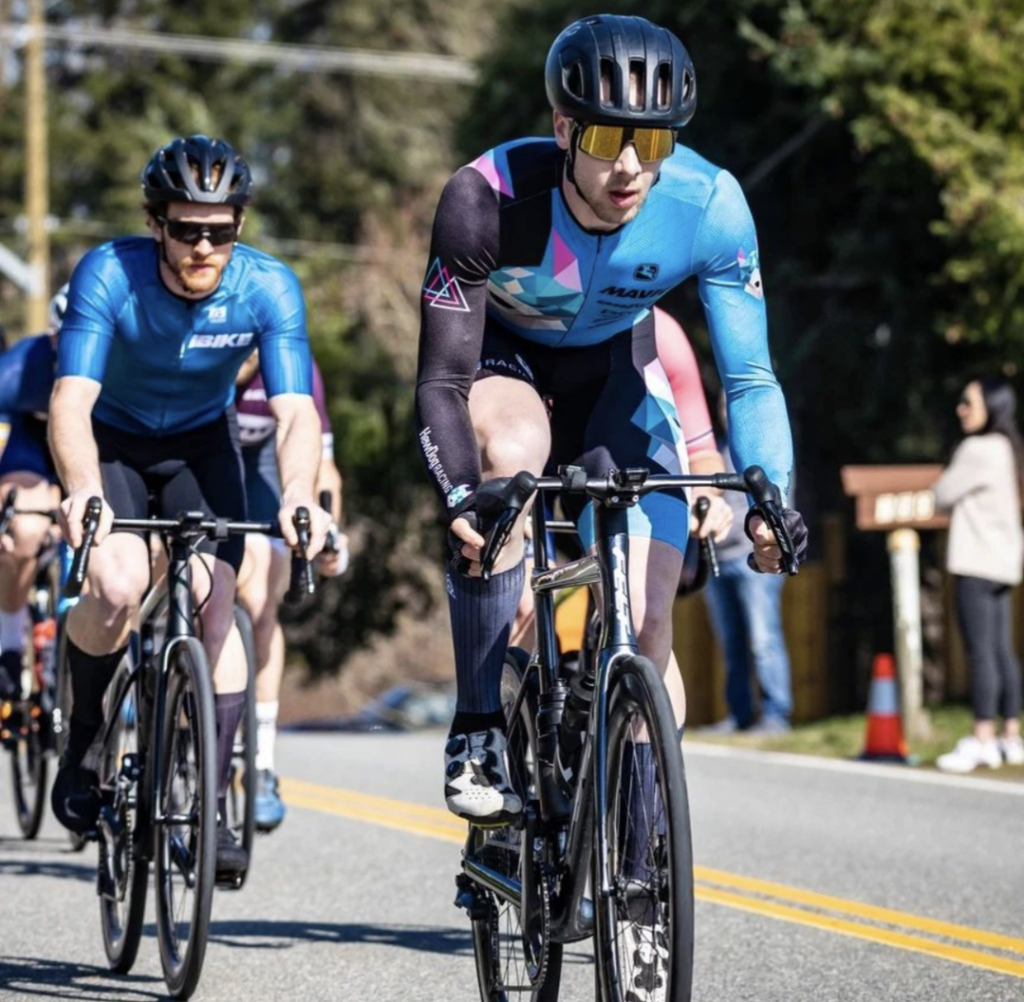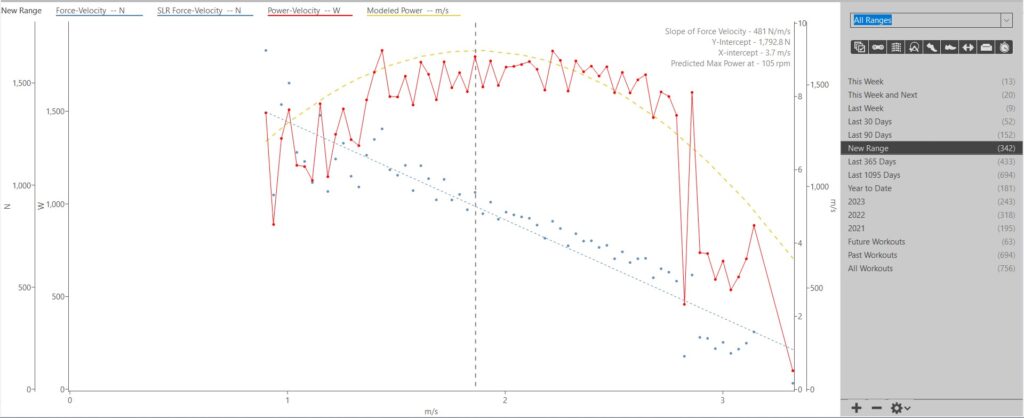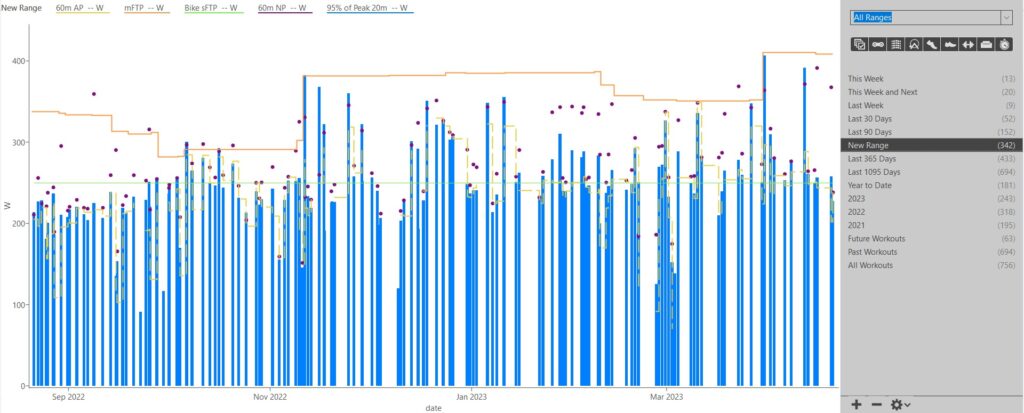Case Study: Taylor Kotwa, Sprinter, Increases FTP 7% in 4 months

When I first started working with Taylor two things stood out. One was his work ethic and the other… Well, the other asset Taylor had was a 1900-watt sprint. As a coach, it’s exciting to see big sprint numbers such as the ones Taylor was producing because that meant he had a pretty good shot at winning just about any field sprint he took part in. Taylor started working with me as a freshly upgraded category 2 racer looking to move up to the ranks of elite category 1 and he is hungry to prove himself at the top level. Taylor’s sprint wasn’t going to be the limiting factor in the hunt for upgrade points, however long-term aerobic development would be crucial in not only securing a category 1 upgrade but also for long term success at the elite level.
I started working with Taylor in the fall of 2022 as he was coming back from time off the bike after a recent injury. He came to me with high expectations and lofty ambitions, so we set to work right away in preparation for the 2023 season. We determined three primary focus points to work on for the 2023 season that keep him on track to meet his goals. The factors we focused on were maintaining Taylor’s monster sprint, increasing Taylor’s FTP and improving Taylor’s race craft and tactical acumen.

Using wko5, based on Taylor’s peak power values we can determine limiters and refocus offseason goals
To maintain Taylor’s sprint power, we focused on force production and neural drive from gym work. We started our gym build with an anatomical adaptation (AA) phase that lasted two weeks. Taylor has a background in weight training, so this phase was shorter than usual, whereas I might hold an athlete in this phase for 3-4 weeks or even longer based on their weight training experience. The goal of the AA phase is to reinforce lifting technique and prepare the muscles and joints for the demands of the heavier lifting phase.
Moving from the AA phase, I transitioned Taylor into a hypertrophy phase, where the main objective is muscle growth through high volume as muscle time under tension is the main driver in adaptation in this phase. We settled on taking on two gym days per week, as this seemed to be the optimal balance for weight training as well as ramping on the bike volume. On the bike training wasn’t very complex during this time and consisted mostly of endurance riding, some cadence drills to reinforce a smooth pedal stroke and a little bit of tempo riding here and there.
After a 15-week block, I transitioned Taylor from hypertrophy into a strength building phase where volume was greatly reduced, and heavy weight and low reps were emphasized, as intensity is the main driver of adaptation during this phase. We started the block sticking to two days a week in the gym, but once high intensity efforts were introduced on the bike, gym work took a backseat, and we transitioned down to one day per week. Coming into the race season, Taylor had maintained a Pmax of 1,859, accomplishing our goal of maintaining peak power while focusing heavily on improving aerobic capacity.

Taylor’s pedal force- velocity (rpm) curve: this helps us determine how the gym work is influencing force production in a sprint
With Taylor already having a world class sprint, most of our off season was focused on long term aerobic development. Having a long timeline to build for the upcoming season, our approach was to keep training consistent with a low but sustainable ramp rate. For the first 12 weeks (about 3 months) working together, most of Taylor’s riding was simply easy endurance riding, like 2/10 RPE easy. We slowly ramped up the volume as the endurance riding was balanced by gym work. Then we supplemented the endurance work with tempo riding and high and low cadence work. Coming into the second week in November, I had Taylor test his 1-minute power, 6-minute power and after some rest we tested FTP using a 25-minute effort. Taylor tested 1 minute at 787w, 6 minutes at 450w and 25 minutes at 395w. With these data points, using WKO5 we were able to hypothesize an early season FTP of 380 watts with a TTE (time to exhaustion) at 34 minutes.
My first goal was to have Taylor increase his TTE with FTP extensive intervals, so with that in mind I designed his next training block to emphasis TiZ (time in zone) at threshold and build up to an hour TiZ during a single session. Over the course of 9 weeks, we built up slowly and surely, starting with 2x20 minute intervals to accumulate 40 minutes of TiZ and moving to 3x16 and eventually up to 3x20. The prescribed power for these sessions ended up being 96-101% of FTP or 365-384. These sessions were highly effective in moving the TTE needle from 34 minutes up to 50+ minutes by the end of the 9 weeks.
Once that objective was met and after some much needed rest, I moved Taylor into an intensive VO2 max build. Taylor completed 7 VO2 max sessions in just 3 weeks, I would not recommend this build for everyone. After some more rest, and with the race season right around the corner, we turned our focus onto quality rest and more volume building. Taylor attended team camp, participated in some early season races and put his offseason fitness to good use by snagging a 4th place finish in his first road race of the year. Once home and rested, we retested his threshold power and he managed to squeeze out 421 watts for 30 minutes, for an updated FTP of 409 watts or an FTP increase of over 7%!
The final piece of preparation for Taylor’s 2023 season success is increasing Taylor’s race IQ and skills. Coming from a multi-sport background, Taylor has risen through the cycling ranks rather quickly but now as he approaches the elite level and the competition improves, he cannot rely on his strength to power him through. One of the best ways to increase race IQ in my opinion is to simply go race your bike, rack up experience and treat each race as a learning experience no matter the outcome. Now that we are in mid-April, race season is in full throttle. We are using a weekly practice race series to gain valuable experience and play out different race scenarios by coming in with clear objectives for each week. Taylor is also flying out to the east coast to participate in Speed Week, where he will race 7 races in 9 days. I think race series like this one and others such as Intelligentsia and Tour of America’s Dairylands are very valuable in improving race acumen and tactics. Having that many days in a row to figure tactics and positioning out are extremely beneficial, I like to call these kinds of series' “crit boot camp”
Put this all together and now we have a recipe for a successful race season. Once Taylor is in the bulk of his race season, training almost takes a back seat. The work has been done, now we focus on performance, which typically involves a lot of recovery between races and Taylor has a stacked calendar. With a nice bump in FTP, maintaining a high Pmax and improving race iq, we’re setting Taylor up for achieving his goals of upgrading to a category 1 rider and being competitive at the elite level.
Coach Taylor Warren currently coaches Mr. Kotwa. Read more about Coach Taylor Warren HERE

